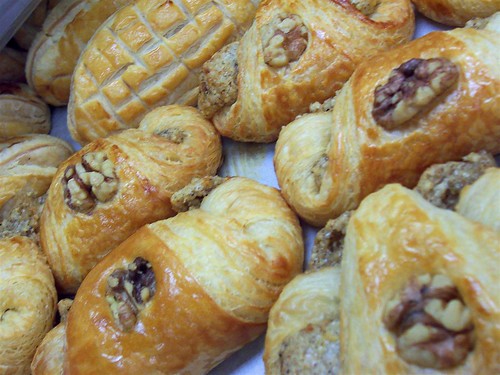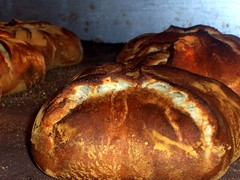Formula: Scratch Italian Puff Pastry 5
. alcohol, bakign procedure, BAKING, Bread, butter, danish station, flours, formula, full development, Italian, pastry, Procedures, puff dough, puff pastry"Pasta Spogolia Al Vermouth Blanco" is a commercial baking formula, and should be reduced for home usage, down to 1/3 or even 1/4 of the original formulation. This formula requires a 20 QT mixer. It is a Full Developed dough. Ingredients are measured by weight - NOT volume.
This is a really lovely puff dough to work with on the bench, it has a nice feel and tastes pleasing.
# = pound (US standard)
BP = Baker's Percent (disregard if not culinary professional)
Formula:
- 3# 10 oz. Organic Bread Flour Baker's % (80)
- 1# 8 oz. butter (use European style, has better plasticity) BP % (20)
- 1 1/2 oz. salt BP % (2)
- 1 oz. malt BP % (1)
- 7 oz. white wine (boxed is fine for this) BP % (10)
- 1# 4 oz. water BP % (27.5)
- 3 1/2 oz. eggs BP % (3)
- 3# 10 oz. butter (use European style, has better plasticity) BP % (80)
- 1# 8 oz. Organic Bread Flour
Procedure:
Dissolve salt in cold water.
In a 20 QT mixer with the hook attachment, mix the flour, butter, salt & water until well incorporated. Add the eggs and white wine. (slowly pour in) [NOTE: The amount of water needed depends on the hydration of the flour - different batches of flour from the mill will be drier than others, thus requiring more water that stated. You should always add extra liquid slowly 1 ounce at a time, to avoid over saturating your dough.]
Give the dough an intensive mix. Wrap the dough in plastic wrap, refrigerate for 30 minutes.
Mix folding butter & remaining bread flour. flatten the folding butter into a square and reserve in the reach-in /refrigerator.
{When working w/ puff dough - it is critical, for the flakiness & layers to form, to NOT push the edges of your dough down (as if pie dough), you must handle the edges delicately, or it will hinder the steam from forming during bake-off (steam = proper puff & rise).}
Place the butter square (from reach-in) on top of your chilled dough, on the lower half of the dough. Fold the dough in half, completely covering the butter - preform these steps:
- Roll out the dough until it's length is 3 times it's width.
- Fold the dough into thirds, like a letter.
- Rotate the dough 90° and roll out the dough until it's 4 times it's width. (Be sure to roll the dough perpendicular to the first turn.)
- Wrap the dough n plastic wrap, place it into the reach-in /refrigerator for 45 minutes.
The dough is now ready to be used. This dough makes up great pastries - turnovers, palmiers, savory pastries - whatever you desire.
Related Posts:
Commercial Formulas Featured On Renaissance Culinaire
Formulas for Muffins, Scones and Pastries Featured On Renaissance Culinaire


































